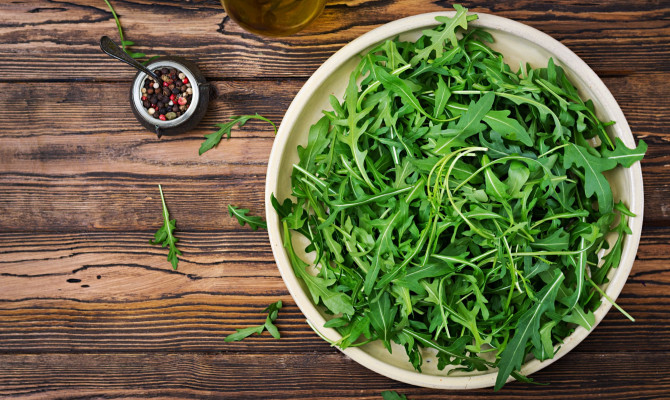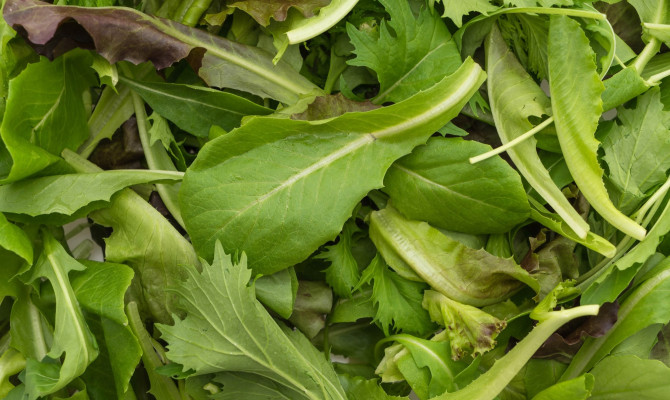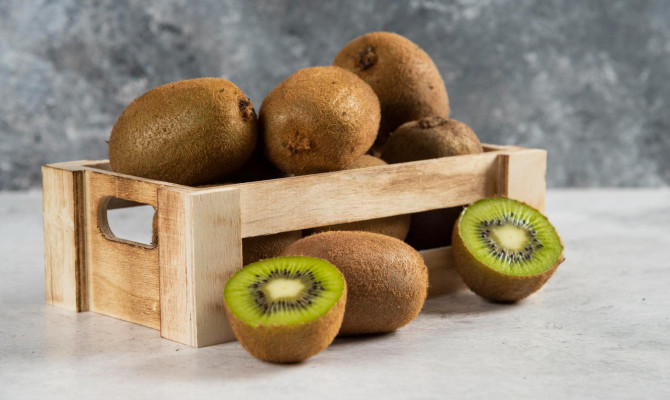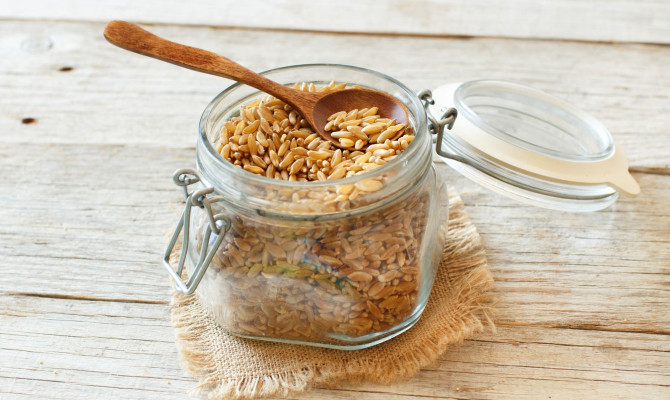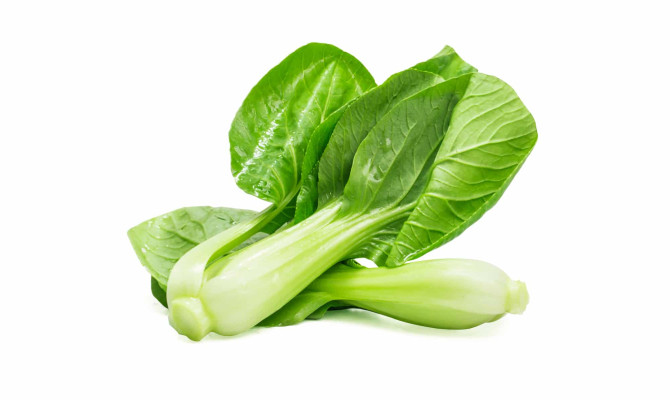Benefits of Barley

- Barley
- 16 Aug 2023
Overview
What is Barley?
Barley is an important cereal grain farmed throughout the world in temperate regions. Barley is one of the oldest crops. With fiber, vitamins, and minerals, barley is a complete grain. These nutrients provide a range of health advantages. This article covers several varieties of barley grains, their nutritional value, health advantages, side effects, risks, methods for preparing and consuming barley, and a few easy recipes.

Key Facts
- Barley belongs to the grass family.
- Hordeum vulgare is its scientific name.
- The Egyptians and the Greeks used barley as a nutritious food source and a medicine1Overview| Researched based study from Agclassroom.org
- Barley is known as Jau in India and is utilized for food and animal feed.
Types
Types of barley
Barley is generally used in different forms and may include
- Hulled barley
- Hulless barley
- Pearled barley
- Barley flakes
- Barley Grits
- Bran flour
Hulled barley
- Hulled barley is treated as little as possible by carefully eliminating the inedible hull and preserving the outer bran. 2Types| Researched based study from Wholegrainscouncil.org
- Nutrient content is higher in whole-grain, hulled barley than in refined, pearled barley.
Hulless barley
- The outer hull of this kind of barley is generally detached from the kernel during harvest because it is so lightly attached.
- This reduces processing time while retaining all of the bran and germ.
Pearled barley
- Available in most groceries and are polished barley that has undergone processing to remove the fibrous exterior hull and some or even all of the bran layer.
Barley flakes
- In a process similar to that used to make rolled oats, barley kernels are steamed, rolled, and dried to produce flakes.
- Due to their larger surface area and gentle steaming, barley flakes cook more quickly.
Barley Grits
- Grits are created by breaking up barley kernels into smaller bits.
- Grits made from hulled or hulless barley are entire grains, whereas grits made by shredding pearl barley are not.
Bran flour
- Barley bran is frequently ground into flour and consumed independently due to its high fiber and nutritional content. 3Types| Researched based study from Foodprint.org
Nutrients
Nutritional Value of Barley
The nutrients in uncooked, hulled, and pearl barley are displayed in the following table per 100 grams (g).
| Nutrient per 100 g | Hulled barley (4) | Pearled barley (5) |
| Energy | 354 kcal | 352 kcal |
| Carbohydrates | 73.5 g | 77.7 g |
| Fiber | 17.3 g | 15.6 g |
| Protein | 12.5 g | 9.9 g |
| Fat | 2.3 g | 1.2 g |
| Potassium | 450 mg | 280 mg |
| Phosphorus | 264 mg | 221 mg |
| Magnesium | 133 mg | 79 mg |
| Calcium | 33 mg | 29 mg |
| Sodium | 12 mg | 9 mg |
| Iron | 3.6 mg | 2.5 mg |
| Zinc | 2.77 mg | 2.13 mg |
| Manganese | 1.9 mg | 1.32 mg |
| Copper | 0.5 mg | 0.4 mg |
| Selenium | 37.7 mcg | 37.7 mcg |
| Folate | 19 mcg | 23 mcg |
| Niacin | 4.6 mg | 4.6 mg |
(Note: g – grams, mg – milligrams, mcg – micrograms.)
Additionally, vitamin A, beta carotene, vitamin K, Vitamin E, folate, and B vitamins like thiamin, niacin, pyridoxine, lutein, and zeaxanthin are abundant in barley.4Nutrients| Researched based study from Usda.gov ,5Nutrients| Researched based study from Usda.gov
Benefits
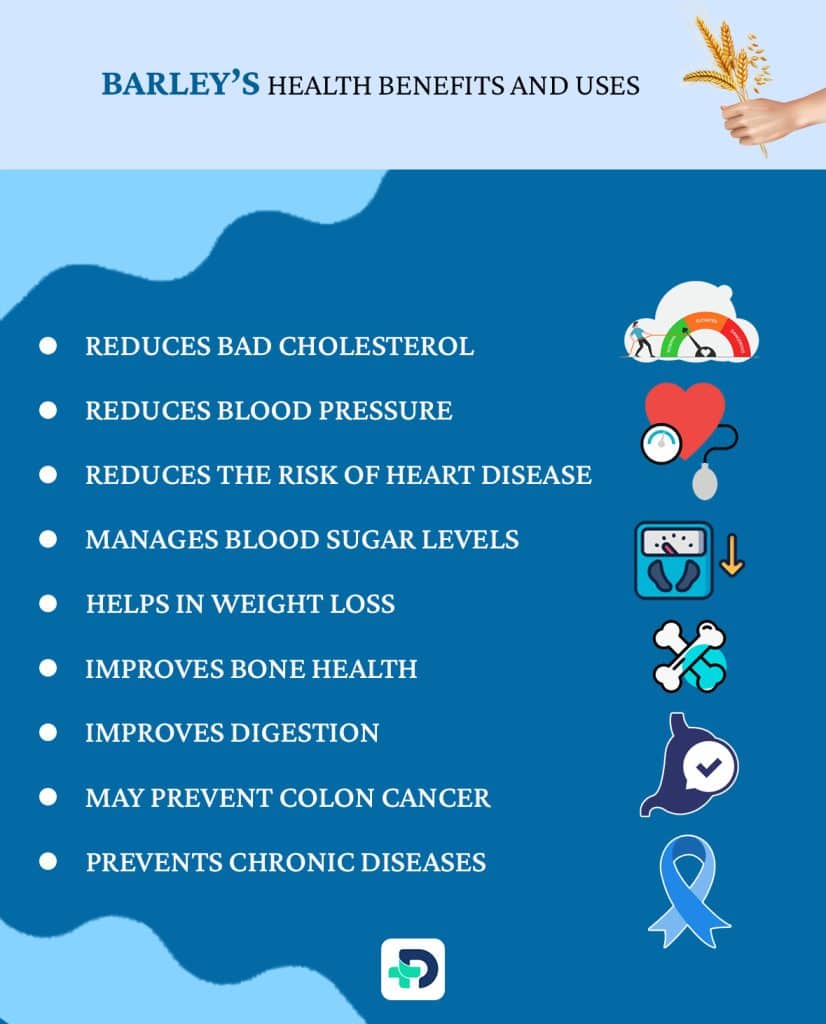
Barley’s health benefits and uses
It has numerous health benefits when consumed and may include the following:
- Reduces bad cholesterol. (LDL)
- Reduces the risk of heart disease.
- Manages blood sugar levels.
- Helps in weight loss.
- Improves bone health.
- Improves digestion.
- It may prevent colon cancer.
To discuss the above health benefits of barley in detail
Reduces bad cholesterol (LDL)
- Adding barley to the diet decreases total and LDL cholesterol.6Benefits| Researched based study from Nlm.nih.gov
Reduces blood pressure
- Including whole grain foods in a healthy diet, whether high in insoluble or soluble fiber, helps lower blood pressure.6Benefits| Researched based study from Nlm.nih.gov
Reduces the risk of heart disease
- Increasing fiber through barley consumption in a balanced diet can lower cardiovascular risk factors by increasing good cholesterol (HDL) levels and decreasing bad cholesterol (LDL) levels in the blood7Benefits| Researched based study from Nlm.nih.gov
Manages blood sugar levels
- Barley made from whole grains lowers blood sugar levels and helps to increase insulin sensitivity.8Benefits| Researched based study from Nlm.nih.gov ,9Benefits| Researched based study from Nlm.nih.gov
Helps in weight loss
- Barley’s soluble fiber promotes weight loss by reducing hunger and boosting feelings of fullness.10Benefits| Researched based study from Nutrition.org
Improves bone health
- The calcium, phosphorus, magnesium, copper, and zinc in barley facilitate improved bone structure and strength. 4Benefits| Researched based study from Usda.gov ,5Benefits| Researched based study from Usda.gov ,11Benefits| Researched based study from Nlm.nih.gov
Improves digestion
- Due to its high fiber content, barley aids digestion by encouraging a healthy gut flora balance and assisting food in passing through the digestive tract.12Benefits| Researched based study from Nlm.nih.gov
May prevent colon cancer
- A slight reduction in the incidence of colorectal cancer was linked to dietary fiber intake, especially fiber from cereal and whole grains.12Benefits| Researched based study from Nlm.nih.gov ,13Benefits| Researched based study from Nlm.nih.gov
Prevents chronic diseases
- To ward off chronic illnesses, one should be advised to consume high-fiber foods, such as barley.14Benefits| Researched based study from Nlm.nih.gov
Differences
How is Barley different from other grains?
What is the difference between Oats and barley?
- Oats are a secondary crop produced from a weed of primary cereal grasses like wheat and barley, whereas barley is a primary crop developed as cereal grass.
- Studies have shown that peak glucose and insulin levels after eating barley are much lower than after eating oats15Differences| Researched based study from Nlm.nih.gov
- Niacin and Vitamin B6 are more abundant in barley than in oat, whereas thiamin, pantothenic acid, and folate are more abundant in oat.
- Compared to barley, oats are higher in calcium and protein.
- Barley has a higher fiber content than oats.
Difference between barley and wheat
- Both grains are healthy, but barley is higher in fiber and cholesterol-lowering beta-glucan, and its processes with less nutritional loss than wheat.
- While wheat is richer in niacin, vitamin B5, vitamin B6, folate, and vitamin E, hulled barley is richer in riboflavin, thiamine, magnesium, iron, zinc, and potassium.
- Since the majority of the fiber in wheat is located in the bran-rich part of the grain, large amounts of fiber are lost during milling. At the same time, barley is exceptionally high in dietary fiber even after processing.
Usage
How to use Barley?
Soaking
- Barley does include antinutrients, which hinder the body’s ability to digest and absorb nutrients, just like all whole grains. The antinutrient content of barley may be decreased, and its nutrients may be absorbed more by soaking or sprouting the grain.16Usage| Researched based study from Nlm.nih.gov
- Due to the outer bran layer in hulled barley, soaking time is longer before cooking. soaking will shorten the cooking process and produce the best flavor and texture.
- Pearled barley does not need soaking before cooking.
Barley recipes
A few simple recipes of barley may include
- Barley is a great option to be added to dishes like stews, soups, cereals, or broths.
- Barley risotto can be made by replacing Arborio rice with barley.
- Instead of using oats in breakfast porridge, try barley flakes.
- One can substitute rice or quinoa with barley.
- When baking, we can combine barley flour with wheat flour.
- Add cooked barley with vegetables and dressings to make a healthy and tasty salad.
Side effects
Side effects of Barley
Consuming barley is generally safe. However, in some people, they may produce side effects like:
- Bloating
- Abdominal pain
- Gas
- Fullness
Precautions
Precautions
- Barley contains gluten, so no one with celiac disease, a gluten allergy, or non-celiac gluten sensitivity should consume it.17Precautions| Researched based study from Coeliac.org.uk
- All goods containing malted barley, including malted beverages, beers, ales, lagers, and stouts, are considered “barley products.”
- To prevent adverse effects like bloating, people who want to transition to a high-fiber diet should gradually add fiber.
Outlook
The Outlook
Barley is a highly healthful and versatile grain. It may be readily added to several meals, is affordable, and can be eaten warm or cold. Or one might purchase barley-containing whole-grain bread. It provides several health advantages and can shield people from chronic ailments, including diabetes, heart disorders, etc. To take advantage of the most benefits, skip pearled barley and choose whole-grain alternatives such as hulled barley or hulless barley.
Any feedback on this article?
 This Articles content was accurate
This Articles content was accurate Very Informative Article
Very Informative Article I have a question or a comment
I have a question or a comment
 This article contains inaccurate content
This article contains inaccurate content This article was not helpful
This article was not helpful I have a question or a comment
I have a question or a comment
We appreciate your helpful feedback!
Checkout our social pages
References
-
Oklahoma Ag in the Classroom
Barley | Key facts
-
Whole Grains Council
TYPES OF BARLEY | Types
-
Food Print
Barley | Types
-
U.S. DEPARTMENT OF AGRICULTURE
Barley, hulled | Nutrients
-
U.S. DEPARTMENT OF AGRICULTURE
Barley, pearled, raw | Nutrients
-
National Library of Medicine
Diets containing barley significantly reduce lipids in mildly hypercholesterolemic men and women | Benefits
-
National Library of Medicine
Lipids significantly reduced by diets containing barley in moderately hypercholesterolemic men | Benefits
-
National Library of Medicine
Effect of a barley breakfast cereal on blood glucose and insulin response in normal and diabetic patients | Benefits
-
National Library of Medicine
Postprandial Differences in the Amino Acid and Biogenic Amines Profiles of Impaired Fasting Glucose Individuals after Intake of Highland Barley | Benefits
-
The Journal of Nutrition
Dietary fiber and energy regulations | Benefits
-
National Library of Medicine
Essential Nutrients for Bone Health and a Review of their Availability in the Average North American Diet | Benefits
-
National Library of Medicine
Dietary fibre, whole grains, and risk of colorectal cancer: systematic review and dose-response meta-analysis of prospective studies | Benefits
-
National Library of Medicine
Consumption of whole grains and cereal fiber in relation to cancer risk: a systematic review of longitudinal studies | Benefits
-
National Library of Medicine
Effects of barley intake on glucose tolerance, lipid metabolism, and bowel function in women. Nutrition | Benefits
-
National Library of Medicine
Comparison of hormone and glucose responses of overweight women to barley and oats | Benefits
-
National Library of Medicine
Enhancement of attributes of cereals by germination and fermentation: a review | Use
-
Coeliac U.K
Grains | Precautions














